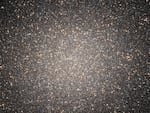
The star cluster Omega Centauri contains millions of stars. The movement of some stars suggests that an intermediate-sized black hole lies at its center.
NASA/ESA/STScI/AURA
Astronomers have used the Hubble Space Telescope to find evidence of an elusive kind of black hole, one that’s about 8,000 times more massive than our sun.
What makes this black hole special is its size, according to a report on the discovery in the journal Nature.
It’s far more massive than a garden-variety black hole, the type that’s created when a dead star collapses in on itself. But it’s also not nearly as big as the kind of supermassive black hole that lurks in the center of galaxies and can hold on the order of hundreds of thousands to millions of suns.
Scientists have long been on the hunt for medium-sized black holes like this new one, because finding them could shed light on the myriad ways that black holes can form and why some grow into gargantuan monsters.
Despite plenty of effort over the years, however, scientists haven’t had luck in finding solid examples of black holes in the so-called intermediate size range, which would include any black hole that’s between 100 to 100,000 times the mass of the sun.
"So people have wondered, is it difficult to find them because they are just not there, or because it's difficult to detect them?" says Maximilian Häberle of the Max Planck Institute for Astronomy, Heidelberg, Germany.
He and some colleagues recently decided to look for one in a large, bright star cluster known as Omega Centauri. This densely-packed, spherical cloud of millions of stars is about 17,000 light years away.
Black holes can’t be observed directly, since their gravity pulls in everything, including light. But researchers can look to see if the gravity of a black hole is affecting nearby objects, including stars.
And the researchers knew that the stars in this particular cluster were being continuously observed by the Hubble Space Telescope, which takes images of the cluster’s central region every year.
“This is actually for technical reasons, to calibrate the instruments,” says Häberle.
Because the telescope had taken high-quality observations that went back more than two decades, Häberle and his colleagues were able to precisely measure the motion of 1.4 million stars in the cluster.
“Our list of stars for which we have measured motions is much, much larger than any previous efforts,” he says, adding that the stars are “all moving in random directions and like a swarm of insects.”
Ultimately, the researchers were able to pick out seven stars in the center that are moving much faster than the others. These stars are actually moving so fast that they really should just shoot out of the star cluster and be gone forever.
The fact that they remain stuck and concentrated at the center, says Häberle, “means that there must be something that is pulling on them gravitationally such that they don't escape. And the only object that can be so massive is an intermediate-mass black hole with a minimum mass of at least 8,000 solar masses.”
The black hole is unlikely to be any bigger than about 50,000 times as massive as the sun, he says, because if that were the case then scientists would expect many more stars to be affected by its gravity.
He notes that there was a previous claim of finding an intermediate-sized black hole candidate in this cluster that dates back to 2008, but that was disputed.
This time around, he says, “I think our evidence is very robust” because of the additional years of data.
What’s more, future observations with the James Webb Space Telescope are already planned, and this powerful telescope will be able to look for tell-tale signs of gas that’s being heated up as it falls into the black hole.
Copyright 2024 NPR